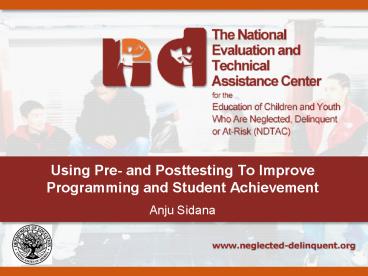Using Pre- and Posttesting To Improve Programming and Student Achievement
1 / 13
Title:
Using Pre- and Posttesting To Improve Programming and Student Achievement
Description:
Using Pre- and Posttesting To Improve Programming and Student Achievement Anju Sidana Gain a better understanding of Part D requirements around and uses of pre-post ... –
Number of Views:233
Avg rating:3.0/5.0
Title: Using Pre- and Posttesting To Improve Programming and Student Achievement
1
Using Pre- and Posttesting To Improve Programming
and Student Achievement Anju Sidana
2
Objectives
- Gain a better understanding of
- Part D requirements around and uses of pre-post
testing - How to properly administer pre-post tests
- How to do more with pre-post testing in your
State - Some common challenges States face in relation to
pre-post testing - Assess the status of pre-post testing in your
State and think through next steps for reaching
your goals (activity) - Learn where to go for more information about
pre-post testing
3
What Exactly Does Pre- and Posttesting Refer To?
- The practice of testing students using academic
achievement teststhat are intended to measure
students academic progress between the
beginning and end of a program or period of
instruction.
4
When Should Pre- and Posttests Be Administered?
- Pretests Shortly after the student enters the
facility - Posttests Upon exit from the facility or at
regularly scheduled intervals (such as every 90
days) - Frequency is limited by
- the number of unique versions of the posttest
- the amount of time needed between tests to
demonstrate measurable progress
5
Part D and Federal Requirements
- Title I, Part D, Section 1431 requires that all
States measure the academic progress of students
served by Part D dollars. - Tables 2.4.1.6/2.4.2.6 of the CSPR (Academic
Performance in Reading and Mathematics) require
States to report pre- and posttest results in
reading and math for students enrolled 90
consecutive days or longer (long-term students). - Section 200.2 of Title 34 of the Code of Federal
Regulations states that Each State, in
consultation with its LEAs, must implement a
system of high-quality, yearly student academic
assessments that includes, at a minimum, academic
assessments in mathematics and
reading/language
6
Other Reasons To Pre- and Posttest (1)
- For students
- Allows for accurate placement
- Allows students to see and track their own
progress - For teachers
- Allows teachers to track progress, catch problems
early, and tailor instruction to individual
student needs - For program managers and education directors
- Allows aggregated data to be used for program
evaluation and improvement - Allows for identification of effective/ineffective
programs and direction of resources
7
Other Reasons To Pre- and Posttest (2)
- For State administrators
- Helps to identify model programs / struggling
programs - Captures data on students that may be missed by
State assessments - Affords an opportunity to share powerful
education information with stakeholders - Facilitates accurate and efficient collecting and
reporting of N or D data at the State level
8
Is Pre- and Posttesting Being Done Properly in My
State?
- Are your programs using tests appropriately?
- Ensure that your States are...
- using tests intended to be administered as pre-
and posttests - administering the tests at the appropriate
intervals to measure progress - using tests designed specifically for the subject
matter being tested - using tests that are appropriate for the
population to whom they are administered
9
Is Pre- and Posttesting Being Done Properly in My
State?
- Are your programs pre- and posttesting the
appropriate students? - Testing AT LEAST all students that have a length
of stay in the facility for 90 days or longer
(long-term students) - Testing all long-term students in AT LEAST
reading and math
10
How Can I Do More?
- Implement a common pre- and posttest
- Ensure proper transfer and credit of testing
information during transition - Assess more students than required
- Think about your end goals to determine first
steps
11
Resources for More Information
- Visit the NDTAC Data Corner at www.neglected-delin
quent.com to find - A Brief Guide for Selecting and Using Pre-Post
AssessmentsProvides basic information about the
ideal characteristics of a pre-post test and
highlights important features to consider when
requesting and evaluating information from test
publishers. - A Look at Legislation Common Pre-Post
AssessmentsDiscusses States that have mandated
the use of a common or pre-approved pre-post
assessment test for Title I, Part D, facilities
and programs.
12
Resources for More Information (2)
- Visit the NDTAC Data Corner at
www.neglected-delinquent.com to find - Common Assessments in Neglected or Delinquent (N
or D) ProgramsLists pre-post tests and
assessments used in neglected or delinquent
programs across the country (compiled 2005). - The NDTAC Assessment Toolkit Measuring Student
Academic PerformanceDesigned to help State
administrators and local program managers track
and improve their academic assessment procedures
and results for students who are neglected or
delinquent.
13
Activity
- Assess the status of pre- and posttesting in your
State and identify next steps































